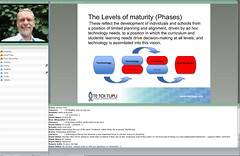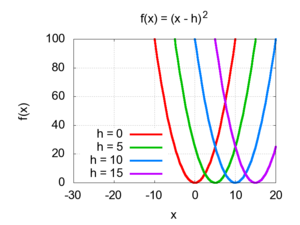Who is this "Homo Interneticus"? This being exists due to “The Virtual Revolution.”
In a recent documentary titled The Virtual Revolution presented by a Dr Aleks Krotoski looks at how the World Wide Web is transforming every aspect of our lives. It also looks at the popularity of social networks and asks how they are changing our relationships. When I look at what we are doing in VPLD and the on line learning that we are all involved in then this documentary and the points it raises have relevance to us and especially the students we teach both now and in the future.
 Image via Wikipedia
Image via WikipediaVirtual Revolution Video 1 of 5 Length 10:58,
Virtual Revolution Video 2 of 5 Length 9:37,
Virtual Revolution Video 3 of 5 Length 10:55,
Virtual Revolution Video 4 of 5 Length 10:67,
Virtual Revolution Video 5 of 5 Length 9:46
Summary: You may add adjust or correct the following
- Johannes Gutenburg Printing Press 1450 churning out books
- 500 years later on a leap- Information still distributed and shared however the big difference is that anyone can create information.
- 20years World Wide Web that created extraordinary access to information, yet to understand the impact it will have on our psychology. The effect and consequences on our relationships and on our brain
- Web effect on human beings then look at South Korea
 Image via Wikipedia
Image via Wikipedia
- South Korea the most wired nation and in this world most digitally enhanced country, 62% 3 to 5 year olds use net at 8hours per week that is twice that to the British. Internet addiction. Cases reported of 18 hours on line each day
- Offers a glimpse on our future
- Distorting students sense of reality
- Unease at students growing up in life on line
- Generation Web-Centered around computers
- Quotes from a family Using Chat-Face Book
- Communicate and look into other peoples lives
- Before web life was boring. What do you think they did before this-Read books
- To take away this will be like removing an arm
- 10,000 hours on line before reach adulthood
- Bebo, My Space and Face Book the largest
- If Face Book was a country it will be the 3rd largest
- Key criticism of FB makes friendship meaningless and how true is this
- Have to understand why FB became so popular
- FB trying to achieve a Network Effect. Theodore Vail The Network Effect
- Comparison to the telephone-one by itself useless, however, add another then another and so on leads to more people to connect with then more people want to join.
- Self sustaining and self fulfilling
- Scale leads to scale
- Value of FB friends
- Is social networking changing how we have friends or not to be able to change our concept of friends
- Primate study on social bonding 50 to 60
- Dunbar bonds made can have Upper limit known as the Dunbar's Number 150. Seen all over human communities
- Has FB changed this limit of friendship
- However Nature is playing out as the average number is well below 150 and usually 5 to 6 in direct contact with each other
- So Face Book not changing our relationships Dunbar's Number and Face Book
- So something deeper is going on with relationships
- Relationships in the loop
- WW2 Anti aircraft study on overcoming the problem of missing their targets-Solution to this was the Loop
- FB innovated use of the Loop
- FB pioneered status update in real time
- A technical solution to social problems
- While web made information available people not aware it is there so Mark Zukerburg completed the Loop using News Feed
- Anything posted onto your site went automatically to others and vice versa. Culture of real time updating and being in the loop and not the number of friends
- Big shift in relationships
- Inspired imitation such as Twitter
- Initially feedback to this was mostly negative
- FB stuck to the loop
- Real time updating in the loop rather then number of friends
- Time on my own increasingly rare with online content both created and consumed
- Living in the loop slowly drowning
- Deeper change in how to use our brain in a different way
- Technology and the mind to work together
- Sherry Turkle
- relationship to technology Web feedback
- Web is like an exciting, innovative metropolis for our young people
- Extra ordinary vision in 1945 with an article published by Vannever Bush As We May Think where he identified Information Over Load
- He did not think our minds to be linear rather associative
- Linking information introduction of the web
- Hyper linking does it make us lazy
- Web Keeps our brain hopping and jumping
- Stops concentration
- Growing up expecting to be able to find information at a moments notice and what does it do to internalize information
- Question Are these just grumblings of an older generation?
- We used to be trained in Linear Thinking-Reading and Writing
- Even at University level get the reaction how much reading do we have to do and how long do we need to read this book?
 Image via Wikipedia
Image via Wikipedia

- Skipping over the virtual sites, not staying at one site for long
- Linear Like hedgehogs like 1 idea, repeat and go back to the same source. Enjoy the peer evaluation environment
- Associative like foxes embrace all kinds of ideas pick things up bounce here and there
- Are young people becoming more fox like? The 12-18 year age group especially as they only know life with the web
- Evidence web changing our thinking
- Professor David Nicholas 40% people never visit the same web page again
- Hyper linked web of information converting us from thinking literally to associatively
- Confirm that Gen. Web are more fox like, remodeled by the web information over load associative thinking
- Society always looks back at the preceding age not the one we are li ving in.
- In the 1960s predicted real time chat Marshall McLuhan
- Measure new media by old media
- Compare to passively consumer type i.e. movies and sitcoms a waste of time as compared to say You Tube. Creative, Sharing rather then just a visual production Brings more people in
- Viral culture people much more engaged
- Direct impact on the world
- You Tube My Space Twitter FB
- Impact in Politics Gen Web engaged done it and done it differently
- Feedback Loops
- Associative Thinking
- For better or worse using web
- Being used by young people today
- Power of the web to connect and collaborate
- Positive impact is that collaboration is the key driver of human progress
- Back to South Korea
- Regularly tops World League Education Tables
- especially in Mathematics and Science
- Not only due to the Education system but connected to the web
- At an early age interact and work together
- Claim that the Gen Web will be more intelligent when compared to the older generation
- Recognize the importance of communication and helping each other solve problems.
- Collective intelligence



























